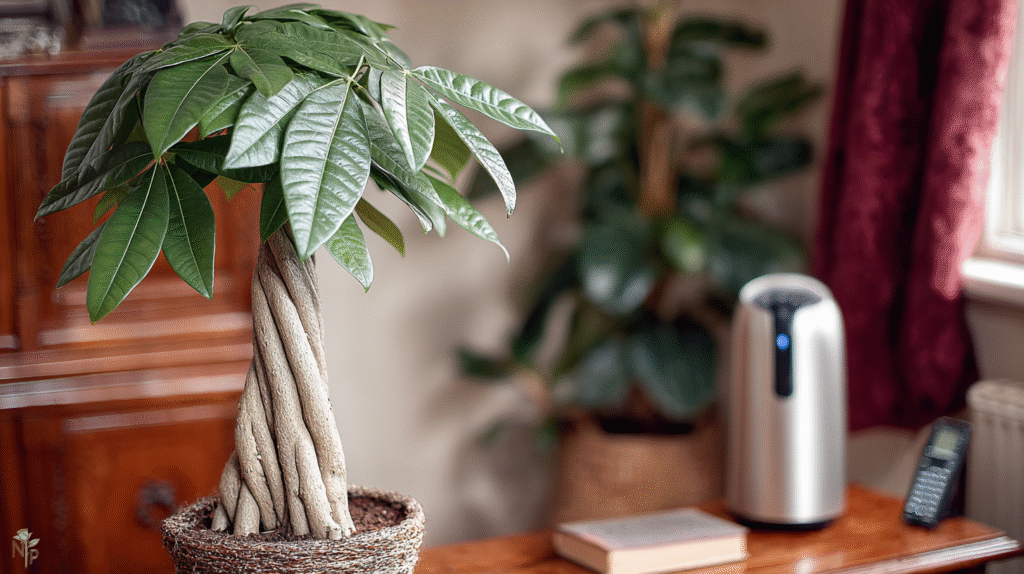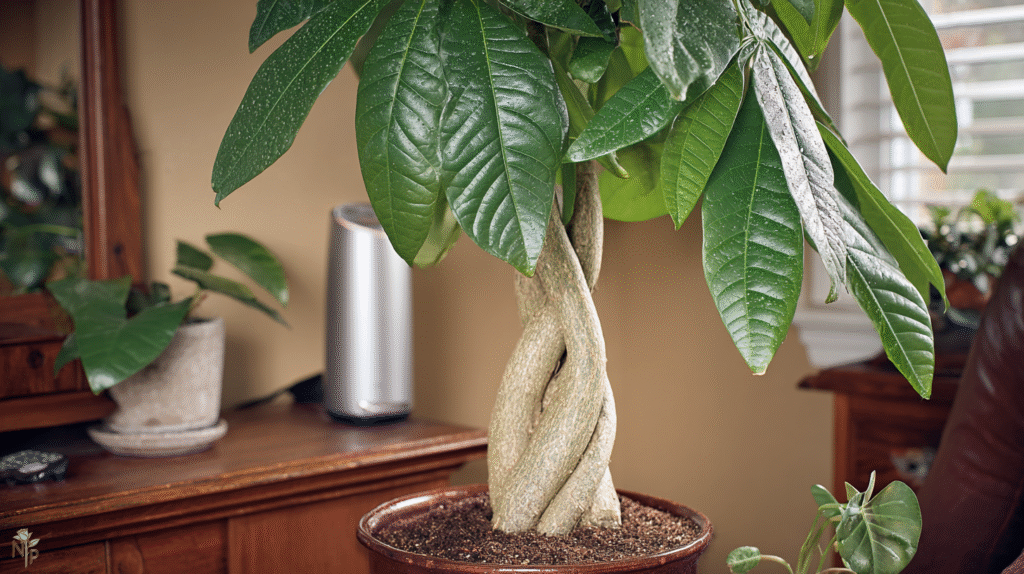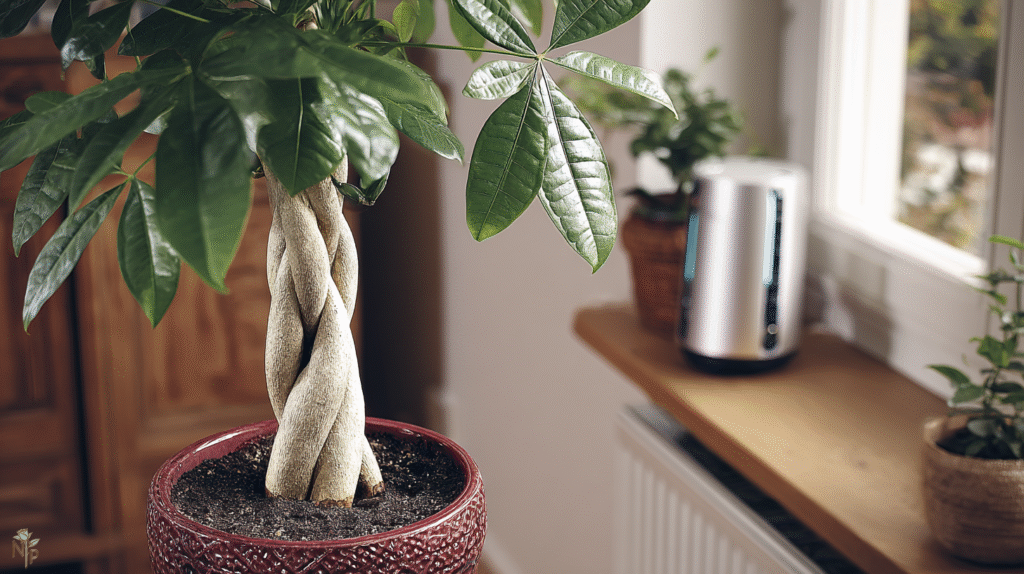My first money tree was supposed to bring me good fortune. Instead, it brought me three months of watching it slowly die while I threw everything at it – more water, less water, fertilizer, new soil, prayers, threats. Nothing worked. By month four, I had a very expensive stick with one sad leaf clinging to life.
The lady at the plant shop had said, “They’re so easy! Just water when dry and give it bright light!” Sure, Karen. That’s like saying “just add ingredients and cook” for making a soufflé.
Fast forward two years and four dead pachiras later (I’m stubborn, okay?), and I finally have one that’s not only alive but actually growing. Like, had to repot it twice growing. New leaves every few weeks growing. The secret? Understanding that money trees aren’t actually trees, they’re swamp plants cosplaying as houseplants, and they have very specific opinions about everything.
The Water Situation Is Weird and Specific
Everyone says “water when the top inch is dry.” I did that. Killed two plants with root rot. Then I went the other way – let it dry out completely. The leaves went crispy and fell off like it was autumn in my living room.
Here’s what actually works: the weight test combined with the stick test. Shove a chopstick all the way to the bottom of the pot. If the bottom third is still moist, don’t water. If it’s dry, pick up the pot. Does it feel surprisingly light? Water tomorrow. Still got some heft? Wait two more days.
For my 8-inch pot pachira, this works out to watering every 10-12 days in summer, every 18-20 days in winter. But here’s the weird part – it needs a LOT of water when you do water. I’m talking water until it’s pouring out the drainage holes for a solid 30 seconds. Then let it drain completely. Never let it sit in water.
The first time I watered this much, I was convinced I was drowning it. Nope. Finally started growing new leaves. Turns out pachiras like to drink deeply then dry out, not little sips constantly. Who knew?

Light Requirements Are a Straight-Up Lie
“Bright indirect light,” they said. “Perfect for offices,” they claimed.
Bullshit.
My pachira in bright indirect light? Barely survived, grew maybe two leaves in six months. Moved it to where it gets 3 hours of actual morning sun through an east window? Thing exploded with growth.
But here’s the catch – afternoon sun will murder it. Found this out when I moved it to a west window thinking “more sun = more growth.” The leaves literally got sunburned. Actual brown, crispy burns like my Irish skin at the beach.
The sweet spot I finally found: East or south-east window where it gets gentle morning sun until about 11 AM, then bright indirect light the rest of the day. Or, if you only have west/south windows, put a sheer curtain up or move it back 3-4 feet from the window.
My office pachira under fluorescent lights? Still alive after a year but hasn’t grown a single new leaf. It’s in a state of suspended animation. Not dying, not living, just… existing.
Temperature Drama Nobody Mentions
Pachiras are more sensitive to temperature than my grandmother. Too cold? Leaves drop. Too hot? Leaves drop. Temperature changes too fast? Believe it or not, leaves drop.
Lost an entire plant because it was next to the AC vent. Didn’t realize the problem until I held my hand where the plant was sitting – arctic blast every time the AC kicked on. Plant went from full to naked in two weeks.
What they actually want: Steady temps between 65-75°F. No cold drafts, no hot air from heaters, no touching cold windows in winter. I keep mine at least a foot from any window in winter because even that cold radiating from the glass bothers it.
The bathroom seemed perfect – warm, humid. Except the temperature swings from hot showers to cold mornings stressed it out. Back to the living room where it’s boring but stable.
Soil Secrets That Changed Everything
Used regular potting soil for my first three pachiras. They all got root rot. Even with careful watering. Even with drainage holes. The soil just held too much moisture for too long.
Now I make my own mix:
- 40% regular potting soil
- 30% perlite (way more than seems reasonable)
- 20% orchid bark
- 10% coarse sand
Looks weird, feels chunky, drains like a dream. When I water now, it flows through in seconds instead of pooling on top. The roots can actually breathe between waterings.
Pro tip discovered by accident: pachiras HATE being repotted. Mine dropped half its leaves after repotting even though I was super careful. Now I only repot when roots are literally growing out the drainage holes, maybe every 2-3 years. And I do it in spring so it has growing season to recover from the trauma.

Humidity Needs (The Missing Piece)
Nobody told me pachiras need humidity. Mine was struggling despite perfect watering and light. Edges going brown, new leaves coming in smaller and smaller. Humidity meter showed 30% in my apartment. Pachiras want 50% minimum.
Bought a humidifier. Within two weeks, new growth appeared. Within a month, the leaves were glossy again. It was like the plant had been holding its breath and finally could breathe.
What doesn’t work:
- Misting (just gets leaves wet, doesn’t raise humidity, can cause fungal spots)
- Pebble trays (raises humidity by maybe 5%, not enough)
- Grouping plants (helps a little but not enough in dry climates)
What does work:
- Actual humidifier running at least 8 hours a day
- Keeping it in naturally humid rooms IF they have good light (big IF)
- Moving it to the shower for steam sessions (I do this monthly, it seems to love it)
The Braided Trunk Conspiracy
Most store-bought pachiras have braided trunks. Looks cool, right? Here’s what they don’t tell you: as those trunks grow and thicken, the braiding can strangle the plant. I watched one trunk slowly die while the others thrived because the braiding got too tight.
If yours is braided and you see one trunk looking worse than others (soft, discolored, not growing leaves), you might need to carefully unbraid it. I was terrified to try this but the alternative was watching it die. Unbraided mine over the course of an hour, being super gentle. Lost some leaves from stress but all three trunks are now healthy.
Fertilizer Truth
Package says fertilize monthly. Did that. Leaves got brown tips, then brown edges, then fell off. Turns out I was basically giving my plant chemical burns.
Now I fertilize at quarter strength every 6 weeks in growing season (March-September), nothing in winter. Use basic balanced houseplant fertilizer, nothing fancy. The pachira grows slower but steadier, and no more fertilizer burn.
Tried those fertilizer sticks once. Disaster. They create hot spots of concentrated fertilizer that burn roots. Liquid diluted in water is the only way.
Common Problems I’ve Faced
Yellow leaves dropping: Usually overwatering or temperature stress. Check soil moisture and look for drafts.
Brown crispy leaf edges: Low humidity or fertilizer burn. Get a humidity meter and back off the plant food.
Drooping leaves but soil is moist: Root rot. Might be saveable if you unpot, cut off black mushy roots, and repot in dry soil. 50/50 survival rate in my experience.
New growth but it’s pale: Needs more light. Pale new growth = struggling to photosynthesize.
Trunk going soft: Game over. Trunk rot is fatal. I tried everything to save one with trunk rot. Nothing works. RIP.

The Growth Pattern Nobody Explains
Pachiras grow weird. They’ll do nothing for months, then suddenly push out 5 new leaves in a week. Then nothing again. This is normal but nobody tells you that.
Mine grows in spurts – usually March-April and August-September. The rest of the time it just sits there looking the same. First year I thought it was dying during these dormant periods. Nope, just thinking about growing.
Also, they grow UP, not OUT. If you want a bushy money tree, you have to prune it. I was scared to cut mine for a year. Finally did it, cutting the top off the tallest trunk. Three new branches grew from that cut. Mind blown.
Why I Keep Trying With This Fussy Plant
After all this drama, you might wonder why I bother. Honestly? When you nail the conditions, pachiras are stunning. Mine went from a sad stick to a 4-foot tall statement piece that everyone comments on. The leaves are glossy, new growth is constant (during growing spurts), and it actually does feel like it brings good energy to the room.
Plus, after killing four, keeping one alive feels like a major achievement. My pachira is proof that I can learn from mistakes. Eventually. After spending way too much money on dead plants.
Just remember: they want swamp conditions (moist then dry soil), rainforest humidity, morning sun only, stable temperatures, and chunky soil. Get those five things right and your money tree might actually bring you luck. Or at least stop dying on you, which feels pretty lucky after you’ve killed a few.






